Reasons to Accept a First-Century Date for the Shroud of Turin
By: Brian G. Chilton, M.Div., Ph.D. | June 23, 2024
Note: The original post mistakenly documented the wrong year for the Chambery fire and the span identified by the Carbon-14 date. The update corrects these issues.
In the 1980s, research into the Shroud of Turin was red hot. However, a 1988 carbon-14 dating of the Shroud seemed to derail those efforts, as the test appeared to show that the Shroud originated in the medieval period, from around AD 1325 with a span that extends from 1260 to 1390. However, the test was immediately met with suspicion because certain aspects of the Shroud seemed to predate 1260.
Are there reasons to believe that the test was flawed and that the Shroud dates to the first-century, the time of Jesus Christ? Actually, there are. This article will examine some of the reasons to believe that the carbon-14 dating was flawed and that the Shroud dates to the time of Jesus.
The Carbon-14 Dating and the Chambery Fire of 1532
The Shroud has an illustrious and mysterious history. We’ll get more into that in a moment. Nonetheless, it is a well-known fact that the Shroud caught on fire during the Chambery fire of 1532, leaving the two prominent parallel lines spanning the length of the Shroud. The Shroud then belonged to the House of Savoy and was kept in a silver casket. On December 4, 1532, a massive fire surrounded the area, causing the silver casket to melt. It was a miracle that the Shroud was not completely consumed in the fire. However, the melting silver did leave burn marks on the linen.
The Poor Clare Nuns and the Holland Cloth
Shortly after the fire, a group of nuns, called the Poor Clare nuns or the Sisters of St. Clare, quickly worked to repair the Shroud by sewing 30 triangular patches on the cloth and adding a backing to the Shroud using a baking cloth to strengthen and stabilize it. The backing is often called the Holland Cloth.[1]
A Microscopic Look at the Linen of the Shroud
When looking at the Shroud through a microscope, it becomes quite evident that there is quite a bit of difference between the three-over-one herringbone weaver of the original linen from the linear design of the cloth used for patchwork by the Poor Clare nuns. Since it is known that medieval fibers were used to patch the cloth, it then becomes feasible if not a certainty that the fibers of the patchwork could have skewed the carbon-14 test. Furthermore, seeing that the test used a piece of cloth from the lowermost corner of the Shroud—a place where it would have been handled for centuries—then it becomes even more certain that the examiners might not have tested the cloth from the Shroud, but rather tested the patchwork applied by the Poor Clare nuns.
Given this cause for concern, the reader would do well to hold the 1988 carbon dating with a great deal of suspicion. Since we have cause to doubt the veracity of this test, then we must ask ourselves if we have other reasons to believe that the Shroud predates the medieval period. And, as the title of the article suggests, we do.
Early Documentary Evidence for the Shroud
The Shroud has a long-documented history that predates the medieval period. In AD 392, St. Jerome reported a passage in the now lost Gospel of the Hebrews that mentioned Jesus handing over a linen cloth to the servant of the priest before visiting his brother James.[2] In the 300s, a Christian by the name of Nino, a man who evangelized Georgia under the Constantinople empire, asked his master, Niafori, about the Shroud. He was told that the burial Shroud had been in the possession of Pilate’s wife for a period of time before being handed over the Luke the evangelist, who in turn stored the Shroud in a safe location before eventually handing it over to the King of Edessa.[3]
Documents imply that the Shroud spent some time in Edessa during the 500s (sixth-century). The Shroud was folded into eight layers, resulting in only the face being shown.[4] To this day, the Shroud has crease layers that indicate that it spent a great deal of time folded into eight-layered segments.
Codex Vossianus Latinus Q69
A codex called the Codex Vossianus Latinus Q69—preserved today in the Rijiksuniversiteit of Leiden—dates to the tenth-century (900s) and speaks of the Shroud of Turin. The document recounts an eighth-century (700s) account speaking of a cloth that contained the imprint of Christ’s body.[5] According to the tradition, the Shroud had been housed in the Cathedral of Saint Sophile at Edessa for an extensive time. In 787 at the Second Council of Nicaea, debates arose over the veneration of holy relics.
The Mandylion of Edessa
During the proceedings, special attention was given to a particular Shroud bearing the image of Christ that had not been produced by the hands of men.[6] The legendary image of Edessa was called the Mandylion and showed only the face of Christ. It mysteriously disappeared in the tenth century. But if the Shroud had been folded as suggested by many Shroud experts, the Shroud of Turin may very well BE the Mandylion of Edessa.
Ironically, it was in the tenth-century that the face of Jesus grew in popularity in both the East and West. In an offensive against the Arab Sultanate of Edessa, the Byzantine Empire came into possession of the Mandylion and presented it in Constantinople. It was at this very time that John Skylitzes reports in a codex that the Shroud of Jesus had arrived in the city. In Constantinople, the Shroud was likely folded in four layers, showing the face, chest, and folded hands of the Man of the Shroud.[7] In 1171, King Louis VII of France venerated the cloth, as did Manuel I Comnenus. All the instances mentioned here occurred well before the date that the carbon-19 test suggested for the Shroud.
Early Numismatic Evidence for the Shroud
Okay, let’s first address the elephant in the room. What in the world is “numismatics”? Numismatics refers to the study of coins and medals. As such, numismatics in Shroud studies examines early coins that depict the image of Christ that bear similar traits of the Man on the Shroud.
Many coins throughout history have held images of Christ that are comparable to the image on the Shroud. However, to keep things simple, we will only look at three of the earliest coins that match the face of the Shroud. If it can be shown that these coins that predate the medieval dating of the Shroud match the face of the Shroud, then clearly there are problems assigning a medieval date to the Shroud of Turin.
Common Numismatic Characteristics Found on the Shroud
Sindonologists (Shroud researchers) have observed several similarities between the face of the Turin Shroud and these early coins, which Fanti and Malfi list below.[8]
- Two wisps of hair in the center of the forehead.
- Hair on one side of the head is longer than the other side.
- A U-shape between the eyebrows that is squared off on the bottom.
- A downward V-shaped triangle on the bridge of the nose.
- One raised eyebrow.
- Large, owl-like eyes.
- Accents on both cheeks, with the right one lower than the left.
- A forked beard.
- The left side of the beard is shorter than the right.
- A common gap in the beard below the lower lip.
- An enlarged left nostril.
- An accent line below the nose.
- A dark line just below the lower lip.
- Some include the “e” or “3-shaped” forehead wound.
- The hair on the left is slightly longer than the other side, possibly representing the “payot” side curls of orthodox Jews.
- A common eye-nose ratio of 1.28 is found in these coins, with some slight alterations.[9]
Another point of interest is that these images are only found in areas where the Shroud and/or Mandylion of Edesa were found.
Justinian II (AD 692)


The first coins printed with the image of Christ that is comparable to the Shroud were first found in the fifth-century (400s). Shortly prior to this time, Christianity had become the official religion of the Holy Roman Empire in AD 313. Before this time, Christ is often depicted as a beardless, short, curly-haired male, bearing a striking likeness to the males of the Greco-Roman period rather than the Jewish males of Israel.
Enormous UV Radiation Producing the Image on the Cloth
So, this bears the question, why did the Shroud images not appear before this time? There is a simple answer to that question. Possessing death cloths was taboo in Jewish culture. Seeing that UV radiation produced the image—which seems extremely likely and would have involved a corona discharge of 300,000 volts at 34,000,000,000,000 (34 trillion) watts and 113,333,333.3334 (over 113 million) amps (keep in mind that less than one amp of electric charge will kill a person)—then, the image would not have appeared until slightly after the initial coronal discharge occurred. Therefore, it may have taken a few months, or even a few years, before the image appeared.
The Justinian II Mint
In the seventh-century, Emperor Justinian II minted the first coin of Christ that bore a likeness to the Shroud of Turin. In the image, two wisps of hair are detected, which may have been more evident in the earlier years of the Shroud but is still seen with careful observation. Additionally, the coin has a nearly identical nose-eye ratio as the Shroud (1.28 on the Shroud, 1.27 on the Justinian II coin). The left side of the beard is shorter than the right, as observed on the Shroud. Additionally, the same owl-like eyes of the Shroud are also found on the coin. The likeness is unmistakable, thus casting doubt on a medieval dating of the Shroud.
Michael III (AD 843)
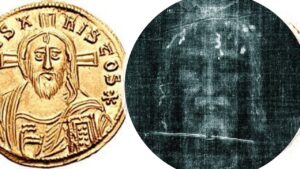
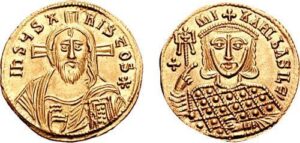
In the ninth-century, Emperor Michael III was coronated to the throne. Michael was a very young man when installed as king. In reality, he was more of a proxy king led by his mother Theodora. Theodora was a devout Christian and an iconophile. She persuaded the young emperor to mint a new Shroud-like coin of Christ in 843. Like the Justinian II coin, the Michael III coin features the two wisps of hair, one bearing a 3-like wave. The same wavy shoulder-length hair is found on the image of Christ, including longer hair on the left, possibly stemming from a Jewish payot. Like the Justinian II coin, the beard is also longer on one side than the other.
Basil I (AD 867)
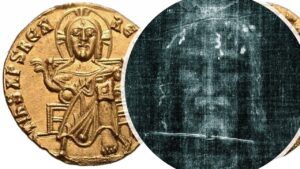
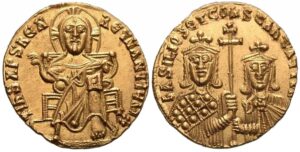
The Shroud was triumphantly brought back to Constantinople around 869–944. For the first time, emperors of the period minted Shroud-like images of Christ seated on a throne. Basil I the Macedonian (867–886) was the first of these emperors.[10] While the face on the coin is a bit degraded from earlier copies due to 1) the image being smaller and 2) the image being cast as a copy from previous coins rather than the Shroud itself, common traits are still found on the coin, including the two wisps of hair, the elongated nose, and wavy hair and beard. The Basil II coin of 976 featured a direct observation of the Shroud and was more in line with the image on the Shroud than Basil I.
Conclusion
All the coins hold remarkable similarities to the image on the Shroud. It is virtually impossible for this to merely be a coincidence. Fanti and Malti calculated the odds and found that we can assert that the Shroud was used for the minting of these coins with a 99.997% certainty.[11] The odds that the similarities were found by sheer coincidence alone are seven chances in one billion of billions.[12] Therefore, we can confidently say that the Shroud existed at least by the seventh-century.
The Shroud and the Mandylion of Edessa
From the similarities found between the historical record of the Shroud and the Mandylion of Edessa, we can also link the Shroud to at least the time of Nino of AD 300. From there, traditions could link the gap between the fourth-century to the first. But we should not despair that we do not have strong links from AD 33 to 300. Given the Roman persecution of Christianity and the Jewish taboo of safeguarding a burial cloth, it is not surprising that we do not possess a stronger link between the times.
Linking the Shroud to the First-Century
Even though stories of the Shroud in this period are found in apocryphal Gospels and traditions, the fact that we have anything concerning the grave Shroud of Jesus speaks to its existence. Given that we also have pollen grains that date to the first-century, AB-type blood stains that are comparable to ancient Jews of the period, and other dating systems that have placed the Shroud of Turin in the first-century,[13] we have every reason to build a cumulative case that the Shroud belongs in the first-century and not the medieval period. Reasonable minds should not allow one test to override multiple other tests that prove the contrary. That is, we have every reason to accept that the Shroud is much older than the carbon-14 test implied.
About the Author
Brian G. Chilton, M.Div., Ph.D.

Brian G. Chilton is the founder of Bellator Christi Ministries and the co-host of the Bellator Christi Podcast. Dr. Chilton earned a Ph.D. in the Theology and Apologetics at Liberty University (with high distinction), a M.Div. in Theology from Liberty University (with high distinction); his B.S. in Religious Studies and Philosophy from Gardner-Webb University (with honors); earned a Certificate in Christian Apologetics from Biola University, and completed Unit 1 of Clinical Pastoral Education at Wake Forest University’s School of Medicine. Dr. Chilton is a member of the Evangelical Theological Society and the Evangelical Philosophical Society. In his spare time, he enjoys reading, working out in his home gym, and watching football. He has served in pastoral ministry for over 20 years, works as a clinical hospice chaplain, and is an Adjunct Professor of Apologetics at Carolina College of Biblical Studies (https://www.CCBS.edu).
https://www.amazon.com/Laymans-Manual-Christian-Apologetics-Essentials/dp/1532697104
https://www.amazon.com/Conversations-about-Heaven-Difficult-Questions/dp/1666762687
Notes
[1] Giulio Fanti and Pierandrea Malfi, The Shroud of Turin: First Century After Christ, 2nd ed (Singapore: Jenny Stanford, 2020), 51.
[2] Jerome, De Viris Illustribus; Fanti and Malfi, Shroud of Turin, 53.
[3] Fanti and Malfi, The Shroud of Turin, 54.
[4] Ibid.
[5] Ibid.
[6] Ibid.; See also John Long, “The Shroud of Turin: Earlier History, Part 2,” BibleArchaeology.org (March 20, 2013), https://biblearchaeology.org/the-shroud-of-turin-list/2632-the-shroud-of-turins-earlier-history-part-two-to-the-great-city.
[7] Ibid., 55.
[8] D. Porter, “What are the Vignon markings?,” GreatShroudofTurinFAQ.com, https://greatshroudofturinfaq.com/History/Greek-Byzantine/Pre-944AD/Vignon/index.html; Fanti and Malfi, Shroud of Turin, 112.
[9] Fanti and Malfi, Shroud of Turin, 112.
[10] Ibid., 90.
[11] Ibid., 144.
[12] Ibid., 416.
[13] J. P. Mauro, “New technology suggests the Shroud of Turin is 2,000 years old,” Aleteia.org (Apr. 22, 2022), https://aleteia.org/2022/04/22/new-technology-suggests-shroud-of-turin-is-2000-years-old.
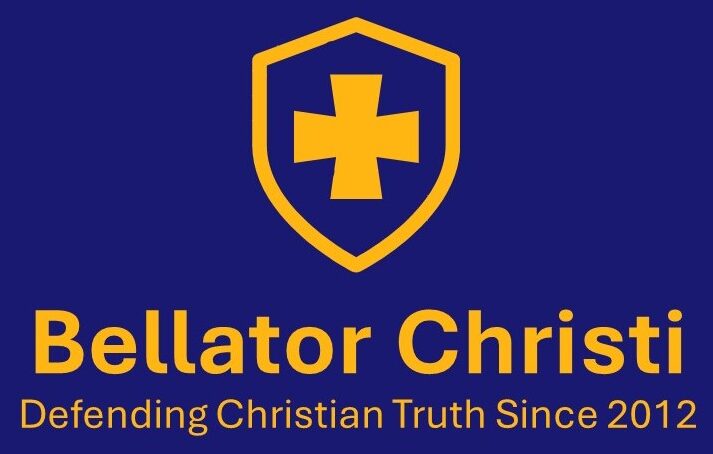





Why is the Shroud of Turin of any importance to a Bible-believing Christian?
Why is it important? The Shroud of Turin could potentially be the burial cloth of Jesus Christ. How would it NOT be important to a Bible-believing Christian?
Because it will not affect my faith or walk with the Lord in any way, and I don’t think it would be useful for evangelism either. The fact that there is some burial shroud will not prove Christ was born of a virgin or rose from the dead, or that Christ is the only way to heaven.